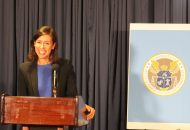Fraudsters Won’t Wait. We Need Stronger Digital Identity at the State and Local Level.
COMMENTARY

Recently, the Internal Revenue Service announced its intention to pilot a government-run tax filing system for federal taxes. This is just the latest example of a government service moving online. Whether renewing a license, applying for government benefits or now filing federal taxes, being able to prove who you are online is increasingly important when it comes to interacting with government.
Yet, there is no agreed upon definition of what exactly “digital identity” means. Ask 10 government technology leaders for a definition and you’ll walk away with 10 different answers.
Put simply, digital identity is critical infrastructure for enabling trust and choice in a modern society.
But this lack of a common definition is part of a larger issue: Today’s identity verification infrastructure is a patchwork of systems across federal, state and local entities. The U.S. lags behind our peers in Canada, the European Union and Australia who have already established a national digital identity ecosystem or are in the process of doing so.
The federal government is taking significant steps to address this after fraudsters siphoned billions of dollars away from pandemic-era programs. In March, the Biden administration released the National Cybersecurity Strategy, which calls for the development of a digital identity ecosystem. Congress passed the American Rescue Plan Act, allocating over $1 billion to build critical infrastructure around digital identity with a focus on improving data sharing, modernizing systems and increasing predictive analytics capabilities.
But the reality is that bad actors continue to be relentless in attacking government programs. At the same time, constituents increasingly expect services to be available online. State and local leaders can’t afford to wait for a nationwide approach to digital identity.
Some states are already taking action and seeing results. In Florida, for example, the Department of Economic Opportunity was able to process 100% of applicants for housing assistance during the pandemic, auto-approving 95% of applicants. The agency accurately disbursed more than $400 million in aid to residents.
So what can be done?
There are three steps that state and local technology leaders can take now to create digital identity programs that enable constituents to access the services they need while preventing fraud.
First, it’s important to understand what an accessible and secure digital identity program looks like. Doing so at the outset can help identify the best technology approaches to implementation. For example, state and local leaders should ensure data sources used to verify identities are inclusive. Millennials, new immigrants and underserved communities tend to lack robust credit histories, which have historically been relied upon to prove someone’s identity. It’s also important that digital identity programs don’t introduce unnecessary friction that makes it more difficult for people to access the services they need. Finally, you can’t fix what you don’t measure. So leaders should look to use solutions that offer transparent reporting on factors like auto-approval rates, manual review rates and disparate impact.
Second, identify and implement new approaches to identity proofing, authentication and fraud prevention. Fraud networks have surpassed legacy systems because they have access to broader and fresher data from ongoing data breaches. Emerging technologies, like biometrics, blockchain, artificial intelligence and machine learning offer effective ways to combat evolving fraud techniques. However, an overreliance on any one technology can put a program at risk for fraud. State and local leaders should identify a combination of emerging technologies and view each of them as tools in the toolkit — not the sole answer.
Lastly, reduce silos and share best practices. No single agency can solve for digital identity and fraud. Fraudsters will always find new ways to attack programs and agencies need to evolve their techniques, tactics and procedures accordingly. This means sharing fraud signals and best practices across a broader network rather than a siloed agency.
At its core, digital identity relies on trustworthy approaches for verifying that the right person is accessing the right services for the right reasons at the right time. Offering an accurate and inclusive identity verification solution can go a long way towards meeting citizens where they are while stopping bad actors in their tracks.
Matt Thompson is a recognized digital identity expert. He currently serves as senior vice president and general manager of public sector solutions at Socure. Socure’s digital identity playbook for state and local CIOs, CTOs and CISOs is available here. Thompson can be reached on LinkedIn.
























